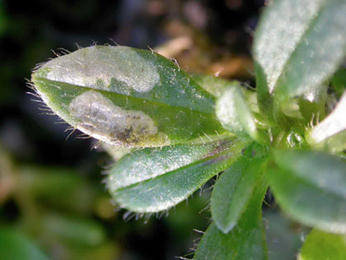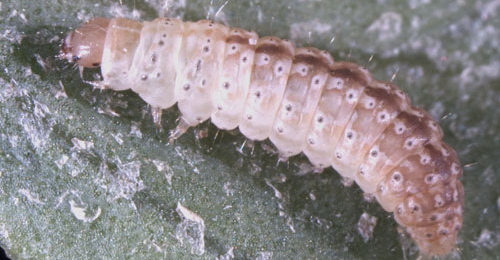|
||||||
|
SALICORNIA. Glassworts. [Chenopodiaceae] |
|
Seven species of Salicornia are recorded in Britain - Long-spiked Glasswort (S. dolichostachya), Common Glasswort (S. europaea), Yellow Glasswort (S. fragilis), Shiny Glasswort (S. nitens), Glaucous Glasswort (S. obscura), One-flowered Glasswort (S. pusilla) and Purple Glasswort (S. ramosissima). All five are native. The BSBI provide a downloadable plant crib for Salicornia and Sarcocornia. Six British miners are recorded on Salicornia. The colophorids Coleophora atriplicis and Coleophora salicorniae are recorded as seed-feeders on Salicornia in Britain. A key to the European miners recorded on Salicornia is provided in Bladmineerders van Europa. |
Key for the identification of the known mines of British |
|
1a > Leaf-miner: The mine starts as a long, narrow, winding corridor running towards the midrib, widening to a blotch. Usually upper-surface, but in small leaves also full-depth parts may occur. The blotch has broad lobes; in their ends most frass is accumulated in the form of green patches or clouds. Sometimes several larvae share mine. Pupation usually in the soil, less often in the leaf (and then generally not in the mine itself but in a small separated mine, that may even be made in the petiole). |
|
 Mine of Scaptomyza graminum on Cerastium glomeratum Image: © Jean-Yves Baugnée (Bladmineerders van Europaa) |
|
|
|
Scaptomyza graminum (Fallén, 1823) [Diptera: Drosophilidae]. |
|
1b > Leaf-miner: Broad mine of variable depth. Frass spread irregularly. Pupation usually internal, seldom external. |
|
|
|
Clanoneurum cimiciforme (Haliday, 1855) [Diptera: Ephydridae]. |
|
1c > Leaf-miner: The first instar larva tends to make a U-shaped mine, whereas later larvae make irregular mines. Final instar larvae spin the leaves together and feed in a silken tube amongst the seeds. Young larvae make a short, spiralled corridor typically U-shaped). This stage is followed by an irregular, sometimes branching, greenish-white blotch. In their final stage the larva lives free in a silken tunnel among the leaves. Pupation in a cocoon of sand grains and detritus. |
|
 Scrobipalpa nitentella larva, dorsal Image: © Willem Ellis (Bladmineerders van Europa) |
|
|
|
Scrobipalpa nitentella (Fuchs, 1902) [Lepidoptera: Gelechiidae]. |
|
1d > Leaf-miner: Long, extremely narrow lower- or upper-surface corridor, with a black or brown central frass line. After a while this primary mine is vacated, and the larva starts making shorter, much broader, full depth blotch mines. In the end the larva lives free among spun leaves. |
|
|
|
Scrobipalpa salinella (Zeller, 1847) [Lepidoptera: Gelechiidae]. |
|
1e > Leaf-miner: Young larvae bore in the midrib, later they mine the leaf from a web spun over of the leaf. |
|
|
|
Scrobipalpa ocellatella (Boyd, 1858) [Lepidoptera: Gelechiidae]. |
|
1d > Leaf-miner: Long, extremely narrow lower- or upper-surface corridor, with a black or brown central frass line. After a while this primary mine is vacated, and the larva starts making shorter, much broader, full depth blotch mines. In the end the larva lives free among spun leaves. |
|
|
|
Scrobipalpa salinella (Zeller, 1847) [Lepidoptera: Gelechiidae] |
|
| Last updated 07-Jul-2019 Brian Pitkin | ||
